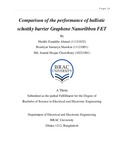| dc.contributor.advisor | Mominuzzaman, Dr. Sharif Mohammad | |
| dc.contributor.author | Ahmed, Sheikh Ziauddin | |
| dc.contributor.author | Shawkat, Mashiyat Sumaiya | |
| dc.contributor.author | Chowdhury, Md. Iramul Hoque | |
| dc.date.accessioned | 2014-09-10T09:34:30Z | |
| dc.date.available | 2014-09-10T09:34:30Z | |
| dc.date.copyright | 2014 | |
| dc.date.issued | 2014-09 | |
| dc.identifier.other | ID 11121032 | |
| dc.identifier.other | ID 11121001 | |
| dc.identifier.other | ID 10221001 | |
| dc.identifier.uri | http://hdl.handle.net/10361/3592 | |
| dc.description | This thesis report submitted in partial fulfillment of the requirement for the degree of Bachelor of Science in Electrical and Electronic Engineering, 2014. | en_US |
| dc.description | Cataloged from PDF version of thesis report. | |
| dc.description | Includes bibliographical references (pages 95-106). | |
| dc.description.abstract | Silicon has been the primary material of choice to meet current needs of the electronics industry. The advancement in technology has led to a growing demand for smaller devices with improved performance. However, silicon as a material has its own limitations; silicon based integrated circuits and the scaling of silicon MOSFET design faces complications like tunneling effect, gate oxide thickness effect etc. To overcome these problems new materials with improved characteristics are needed.
In recent times, graphene and carbon nanotube have shown huge promise as materials that can replace silicon-based materials in the future due to their outstanding electrical properties and other characteristics. Simulation studies of graphene nanoribbon field-effect transistors (GNRFETs) and carbon nanotube field-effect transistors (CNTFETs) are presented in this research paper using models that have been systematically developed and are of increasing rigor and versatility. This thesis covers the studies and modeling of graphene nanoribbon and carbon nanotube, which includes band structures and current-voltage graphical plots. Also, an analysis has been presented which shows the effect of varying temperature, relative dielectric constant, chirality, channel length and gate oxide thickness, on the device performance, in particular on the drain current.
The main purpose of this paper is to the study behaviour of schottky barrier graphene nanoribbon transistors and carbon nanotube transistors. The focus here is on the transfer and output characteristics of these transistors and observing the parameter changing effects on them. The simulation study is carried out using NanoTCAD ViDES program and the results obtained are used to make a comparative analysis of the device performance of GNRFET and CNTFET. Also, the simulation results obtained in this papers are compared with the simulation results of other research groups to verify our results. | en_US |
| dc.description.statementofresponsibility | Sheikh Ziauddin Ahmed,
Mashiyat Sumaiya Shawkat,
Md. Iramul Hoque Chowdhury | |
| dc.format.extent | 177 pages | |
| dc.language.iso | en | en_US |
| dc.publisher | BRAC University | en_US |
| dc.rights | BRAC University Internship reports are protected by copyright.
They may be viewed from this source for any purpose,
but reproduction or distribution in any format is prohibited
without written permission. | |
| dc.subject | Electrical and electronic engineering | en_US |
| dc.subject | Carbon Nanotube | en_US |
| dc.subject | Graphene Nanoribbon | en_US |
| dc.title | Comparison of the performance of ballistic schottky barrier graphene nanoribbon FET | en_US |
| dc.type | Thesis | en_US |
| dc.contributor.department | Department of Electrical and Electronic Engineering, BRAC University | |
| dc.description.degree | B. Electrical and Electronic Engineering | |

